A review of graphene-based films for heat dissipation
LI Hao-liang,XIAO Shu-ning,YU Hong-liu,XUE Yu-hua,YANG Jun-he,3,*
(1.School of Materials Science and Engineering, University of Shanghai for Science and Technology, Shanghai 200093, China;2.School of Medical Instrument and Food Engineering, University of Shanghai for Science and Technology, Shanghai 200093, China;3.Prytula Igor Collaborate Innovation Center for Diamond, Shanghai Jian Qiao University, Shanghai 201306, China)
Abstract:Graphene,because of its outstanding thermal and electrical conductivity,has been regarded as one of the promising materials for heat dissipation and electromagnetic shielding,and has recently attracted widespread attention.We summarize the current research status of reduced graphene oxide films,graphene films and graphene-based composite films for thermal management,including their preparation and applications.The key factors that determine the thermal conductivity of graphene films are discussed to figure out the main challenges,especially in the scalable manufacture of graphene-based films in the near future.
Key words:Graphene based film;Thermal management;Key factors for heat dissipation
1 Introduction
With the promotion and popularization of 5G communication technology,heat dissipation has become a generic problem in electronic devices.The integrated chip industry,followed by Moore’s law since the 1960s,is still pursuing extremely high performance which brings great challenge for the thermal management especially in portable electronic systems.The traditional materials for heat dissipation are rely on the metals,such as alumina (~220 W(m k)−1) or copper (~381 W(m k)−1),which can hardly meet the demand not only for the local hotspot cooling (critical heat flux~1 000 W cm−2)[1],but also for the poor portability and flexibility.The pyrolytic graphite film,prepared by the graphitization of polyimide at 3 000 °C,has been applied in the cell phone or laptop with a moderate thermal conductivity (κ)~1 000 W(m k)−1.Moreover,the cost of large-scale production of graphite film is relatively high,because of the low yield and the high energy consumption during the graphitization.Therefore,it is of great importance to develop novel substitutes for the efficient heat dissipation of the integrated devices.
It is always an issue until the discovery of graphene,an atomic layer thick carbon with a sp2hybrid structure[3].As is mentioned in Fig.1,the intrinsicκof mechanical exfoliated suspended graphene is 5 300 W(m k)−1(far more than that of bulk graphite~2 000 W(m k)−1[2]or single walled carbon nanotubes~3 500 W(m k)−1[4,5]),which was firstly measured by Balandin’s group with Raman technique[6].Henceforth,graphene,owing to its extremely highκand excellent mechanical property,has been regarded as one of the promising substitutes and has motivated various studies on graphene and its derivates such as graphene films[7–10],fibers[11,12],composites[13–15],and laminates[16,17] for the thermal management applications.
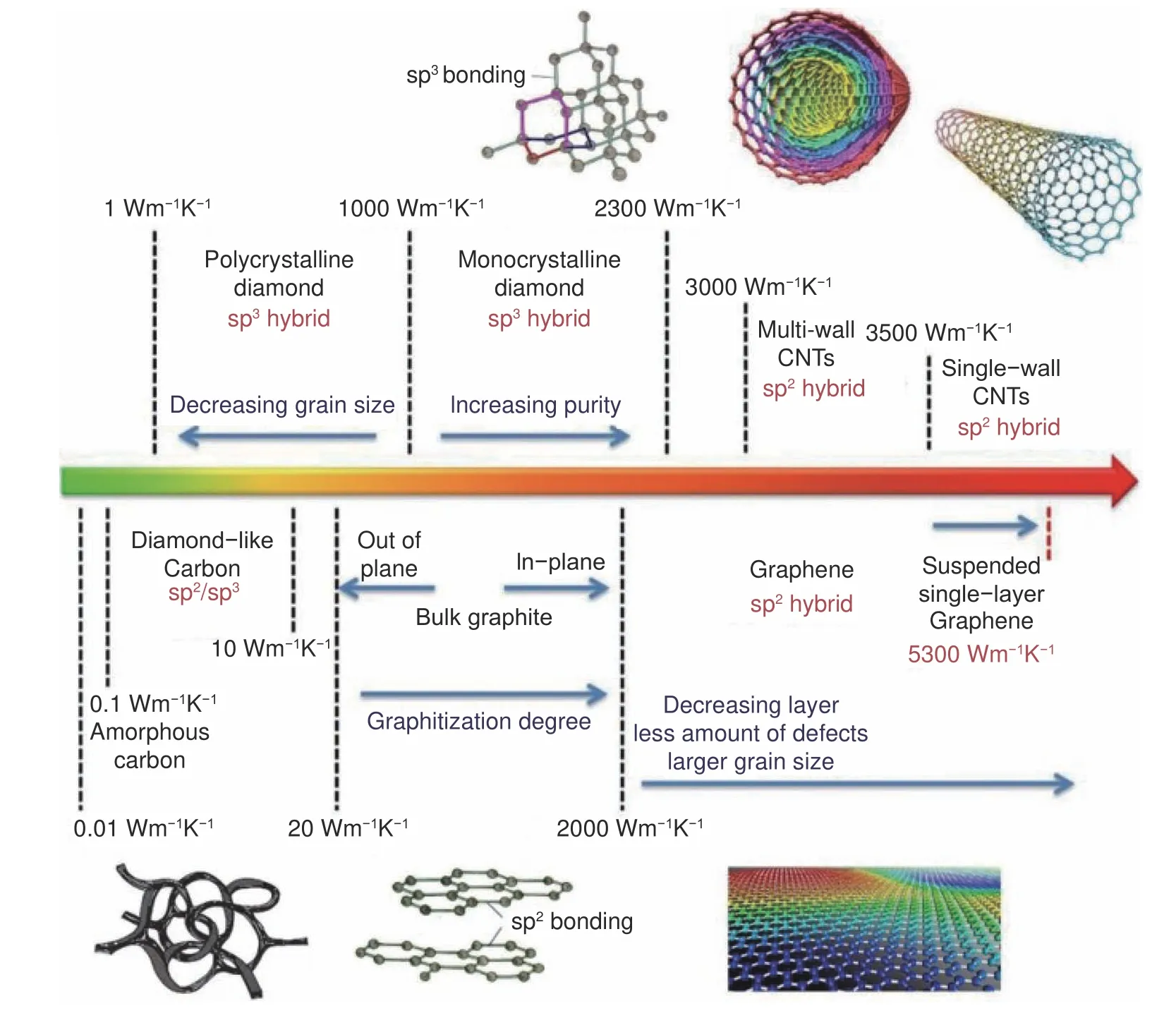
Fig.1 Illustration of thermal conductivities of various carbon materials[2].(Reprinted with permission).
In this paper,we review the recent progress on graphene-based films and their composites for heat dissipation briefly.Then,the mechanism and the major factors affecting the heat dissipation efficiency such as the functionalization of graphene,the lateral size and the orientation of graphene sheets,are also summarized and discussed.At the end of this review,the challenge and the development trend is commented to deliver guidance for the next generation graphene based 2D materials for thermal management.
2 Graphene based films for heat dissipation
In this section,the state of art of the preparation of the graphene films and their derivatives is summarized,including different precursors and their contribution to the improvement inκof graphene films.
2.1 Mono-or few-layer graphene film
To obtain the mono layer graphene with a perfect lattice structure,mechanical exfoliation from highly oriented pyrolyzed graphite film (HOPG) is one of the most feasible methods[18,19].These micronsized graphene sheets are widely used for the fundamental research about the heat transfer or phonon transportation in graphene lattice.On the other hand,with the rapid development of the chemical vapor deposition (CVD) technique,high quality single or few layer graphene films are available for research or applications.Gao et al.applied a thermal CVD method to growth monolayer graphene film.The temperature of the hot spot was decreased from 394 to 381 K when it was applied on a Pt chips[20].
The ultrafast growth techniques have pushed the scalable preparation of CVD graphene.For instance,an inch-sized single-crystalline graphene was grown fast on a Cu-Ni alloy substrate[21].Xu et al.developed an ultrafast CVD by oxygen supply to grow singlecrystalline graphene[22].But it still remains obstacles in applications of CVD graphene film as a heat spreader,because of the transference of graphene from the substrate without damage in the lattice structure is relatively difficult.
2.2 Reduced graphene oxide (rGO) films
Although the single or few layer graphene shows an excellent in-planeκ,it is still obstacles to apply directly on the hot spots without a substrate.Therefore,great efforts in the assembly methods of graphene or GO sheets have been taken to obtain free-standing rGO films.Since Rouff’s group prepared the GO film by the vacuum filtration with excellent tensile strength[23],GO has been widely applied to fabricate 2D films,owing to its excellent dispersibility in water or organic solvents.Over the last decade,various assembly methods have been developed,such as electrospinning[24],wet-spun[7],casting[8,25],spraying[26,27],blade and bar coating[10,28],based on the interaction of hydrogen bonds to form a layer-by-layer and compact structure[29].For instance,the rGO film,prepared by a mild evaporation process in a Teflon disk,exhibited aκof 1 100 W(m k)−1and an excellent EMI shielding performance of 20 dB[30].In Fig.2(a-e),Xin et al.reported the electro-spray deposition of GO film with a continuous roll-to-roll method,and after the annealing at 2 200 °C,theκof the film reached~1 200 W(m k)−1[11].An ultrathin rGO film was fabricated with only 0.8 μm by a dry-bubbling method to reduce the phonon interfacial scattering and the reportedκwas~3 200 W(m k)−1[31].
More recently,the continuous winding production of rGO film,combined with blade coating,mild thermal reduction (140 °C) and graphitization (2 850 °C) was approached with aκof 1 204 W(m k)−1.Notably,as shown in Fig.2g and 2h,the thickness of the rGO film reached~200 μm with the self-fusion method which exhibited a promising future for industrial production[33].A rapid roll-to-roll process to fabricate continuous GO films was reported by Liu et al.After the reduction treatment by an intensive Joule heating method,theκand the electrical conductivity of the rGO film reached 1 285 W(m k)−1and 4 200 S cm−1,respectively[34].Huang et al.proposed a bar coating strategy to prepare a GO film,which after the graphitization treatment had aκvalue of 826 W(m k)−1[28].To improve the heat flux through the thermal conducting film,an ultrathick rGO film fabricated by a self-fusion process was developed to fuse rGO film together in a moisture atmosphere,the film with asub-millimeter thickness exhibited high thermal and electrical conductivities of 1 224 W(m k)−1and 6 910 S cm−1,respectively,which shows promising applications in thermal management and EMI shielding[32].
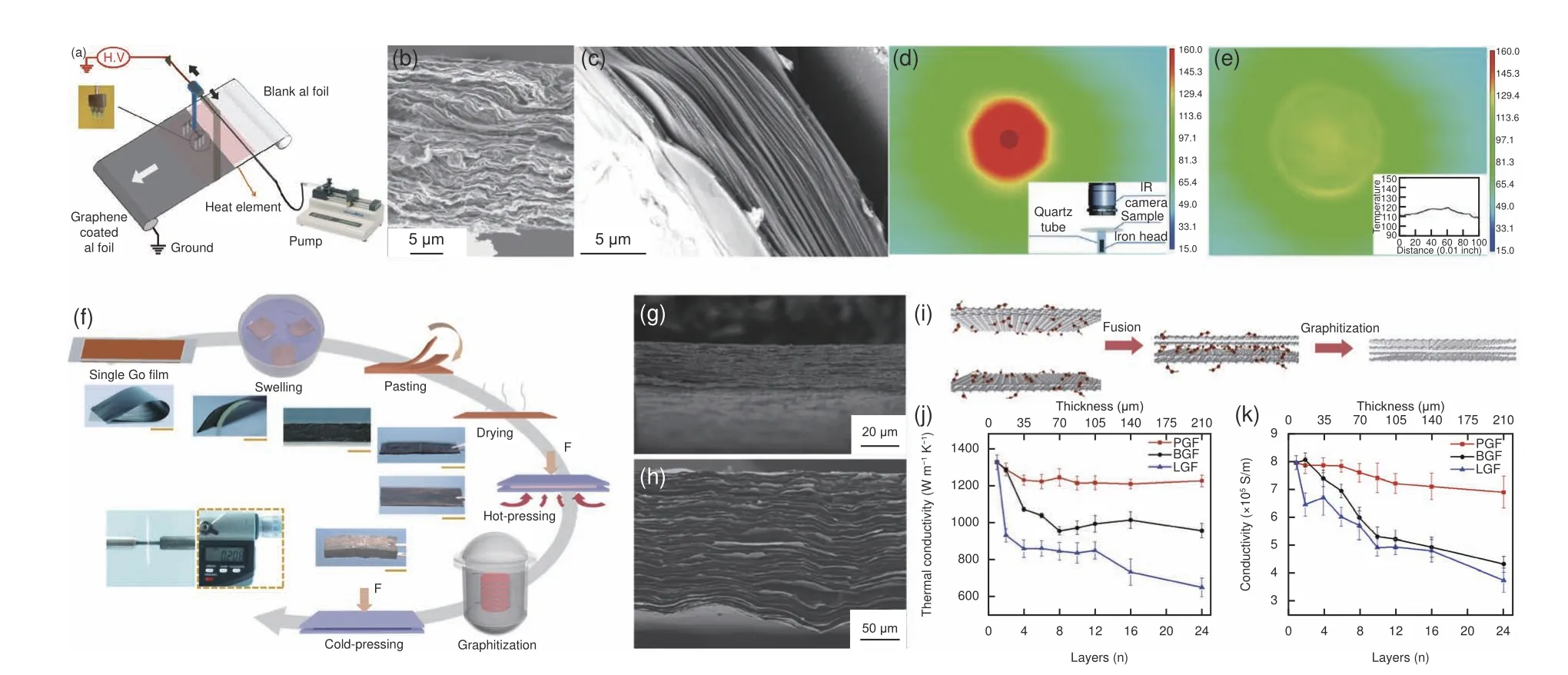
Fig.2 (a) Schematic illustration of the electrospinning method.(b,c) The SEM images of as-obtained GO and rGO films.(d,e) The Infar-red photos for heat dissipation performance[24] (Copyright 2014,John Wiley and Sons).(f) The preparation procedure of self-fused rGO films.(g,h) The SEM images of rGO films with different thickness.(i) Mechanism diagram of the self-fusion process.(j,k) The thermal and electrical conductivities of rGO films with different layers or thicknesses[32] (Copyright 2020,Elsevier).
As listed in Table 1,most of the rGO films only exhibited an averageκof~1 300 W(m k)−1,which are much lower than that of the bulk graphite(2 000 W(m k)−1).Due to the intrinsic structural defects involved during the oxidation treatment of GO.This inharmonic lattice structure may lead to severe phonon scattering so that the heat dissipation performance of the as-obtained rGO film may be afftected.Therefore,the carbonization and the graphitization treatment of the GO film,as high as over 2 800 °C,is necessary to restore the crystallinity of graphene sheets in order to guarantee the heat dissipation performance.
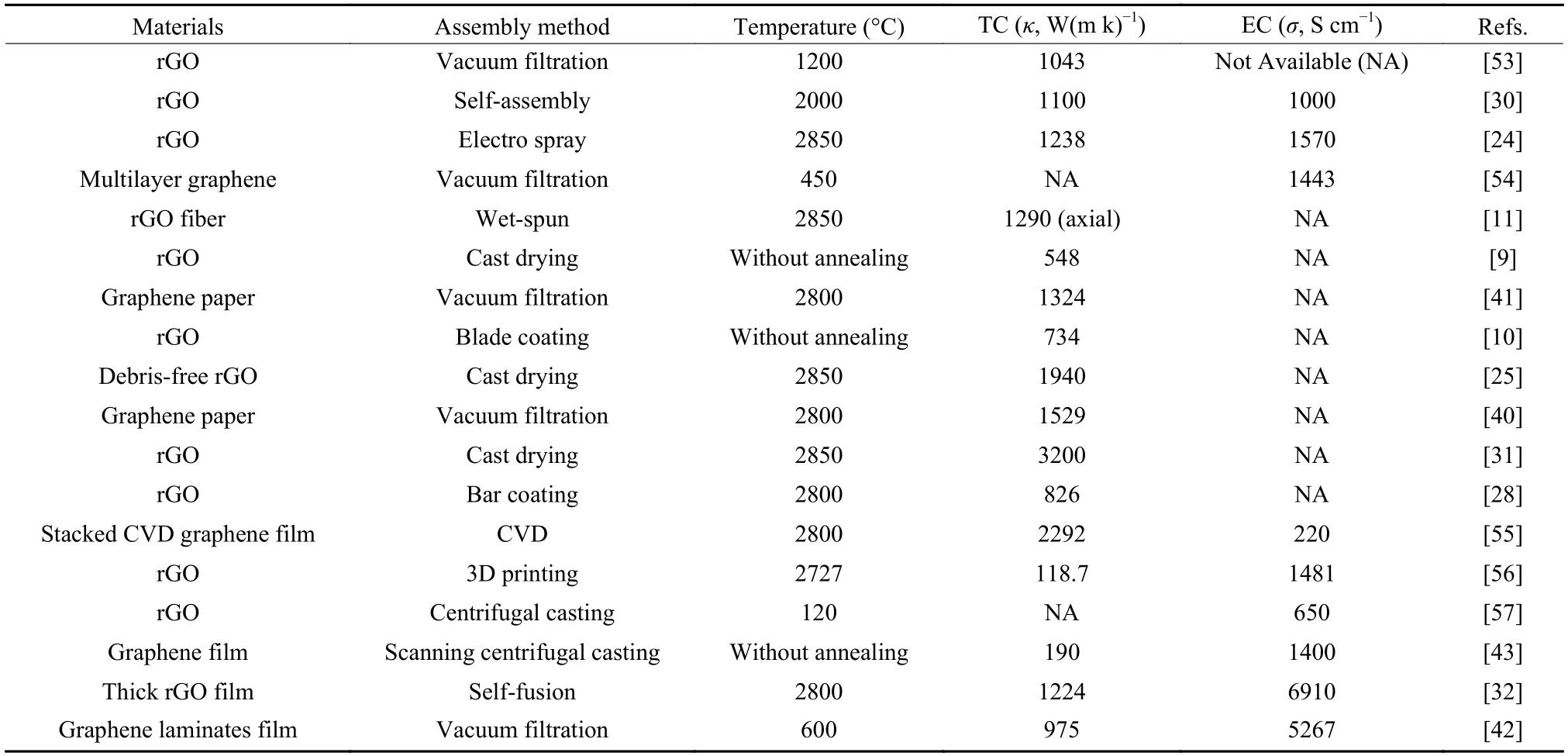
Table 1 The state-of-art preparation of graphene-based films for thermal management.
2.3 Graphene films (GFs)
The graphene,prepared by mechanical exfoliation,such as ball-milling[35],shear force exfoliation[36],ultrasonication (i.e.liquid phase exfoliation)[37],supercritical fluid method[38],and novel layered-engineered exfoliation[39],shows a great advantage in decreasing the defects or heteroatoms introduced by the oxidation treatment.Hence,these graphene films assembled by graphene powder also exhibited promising performance compared to the rGO films.In Fig.3(a-e),Teng et al.prepared a graphene paste with a high concentration by a ballmilling method.The GF paper was filtrated and compressed to achieve a highκof 1 529 W(m k)−1[40].The sodium lignosulfonate assisted ball-milling process was developed with an excellent yield of graphene nanosheets and theκof as-obtained graphene film reached 1 324 W(m k)−1[41].More recently,Wu et al.proposed a filtration process of a graphene laminate slurry for scalable production,theκof the graphene film was 975 W(m k)−1[42].

Fig.3 (a) The preparation of graphene films by ball-milling and vacuum filtration methods.(b,c) The surface and cross-section morphology of graphene film.(d,e) The thermal conductivity and heat dissipation performance of graphene films[40] (Copyright 2017,John Wiley and Sons).(f) The illustration of centrifugal dip coating of graphene film and the optical photograph.(g-i) SEM images of the as-obtained graphene film.(j-l) The thermal,electrical conductivity and the EMI shielding performance of graphene film[43] (Copyright 2020,John Wiley and Sons).
But the graphene powder shows limitation for application due to the poor dispersibility of mechanical exfoliated graphene sheets.Although the implement of surfactants can improve the exfoliation efficiency,the presence of the residual additives may introduce extra defects into the graphene sheets during the carbonization treatment,resulting in a decline in κ.On the other hand,the mechanical property of GFs is inferior to that of GO film due to the weak Van der Walls interaction between the graphene basal planes.In this regard,a novel scanning centrifugal casting method,as shown in Fig.2(f-l) was used to enhance the alignment of graphene sheets to improve the heat dissipation and EMI shielding performance to 190 W(m k)−1and 93 dB,respectively[43].Moreover,a series of modified exfoliation methods were also developed to grafting functional groups at the edge of graphene sheets,such as carboxyl or hydroxyl functional groups[35,44] to achieve better mechanical properties,with the minimal damage of the sp2harmonic lattice structure.
2.4 Graphene based composite films
It is a general problem that the lateral size of rGO or graphene sheets is relatively small due to the top-down preparation strategy.The presence of great amounts of boundaries between adjacent sheets may lead to severe phonon-boundary scattering,resulting in a decline inκ.Hence,there is a strong motivation for develop graphene based composite films to fill up the inner voids or gaps between graphene sheets.For instance,Kong et al.applied highly conductive carbon fibers to connect GO sheets by hot-press carbonization with an enhancement inκto 973 W(m k)−1[14].Hsieh et al.developed a graphene/CNT composite film,the inplane and out-of-planeκreached to 1 991 and 76 W(m k)−1,respectively[45].The expanded graphite was also applied to combine with GO to improve the thermal conductivity and EMI shielding performance[46].More recently,as shown in Fig.4(a-f),the synergistic effect of graphene and CNTs showed aκof 1 154 W(m k)−1and the EMI shielding performance of~50 dB[27].The Fig.4(gl) demonstrated modified spraying coating of graphene onto the CNT yarn film that was reported to have aκof 1 056 W(m k)−1[26].The presence of carbon fibers or CNTs plays an important role,as mentioned in Fig.4d,to abridge an effective path for heat dissipation between the graphene or GO sheets.

Fig.4 (a) The bar coating preparation of rGO/CNT composite film.(b,c) SEM and TEM morphology of the composite film.(d) The illustration of CNTs as thermal pathway to connect the graphene sheets.(e,f) Thermal and EMI shielding performance of the composite film[27](Copyright 2018,Elsevier).(g) The illustration of spraying coating of GO on CNT yarns.(h,i) SEM and TEM images of the rGO/CNT composite film.(j) The demonstration of rGO/CNT to improve the heat transfer performance.(k) The thermal conductivity of the composite films with different GO loadings.(l) The infra-red photos of the composite film compared with copper sheet[26].(Copyright 2017,Elsevier).
In addition,as displayed in Fig.5,Li et al.applied PI pulp as skeleton followed by filtration of a GO solution to prepare a rGO/PI composite film with aκof 1 428 W(m k)−1after the graphitization to turn the PI into the conductive graphitic structure[47].But notably,the weak Van der Waals interaction between graphene and these low dimensional carbon materials led to a relatively poor flexibility of the composite films under bending at small radii.
On the other hand,the chemical modification of rGO sheets to achieve the connection by covalent bonding is also an effective way to restore the boundaries between the graphene sheets.A silane-functionalization strategy was introduced to reduce the thermal resistance of graphene film,whoseκvalue was increased by 56% to 1 642 W(m k)−1[48].As shown in Fig.5(f-k),Wang et al.applied 2D g-C3N4as a linker for stitching the rGO sheets with an enhancement inκby 17.3%.When the rGO/g-C3N4composite film was applied on a CPU chip,the working temperature was reduced more than 10 °C within 40 seconds[15].
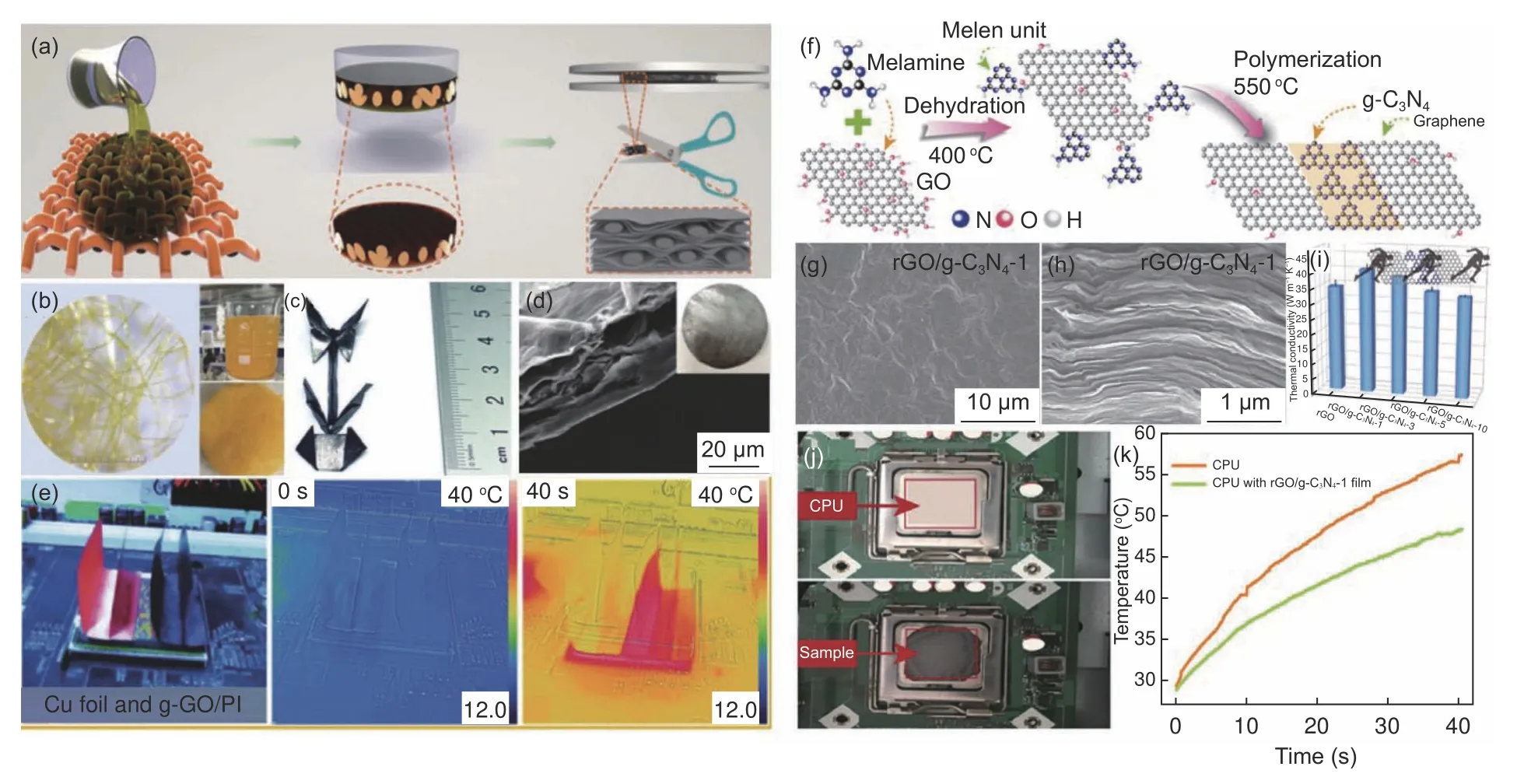
Fig.5 (a) The casting process of a GO solution on PI pulp.(b-d) The optical photos and SEM morphology of PI pulp and the graphitized GO/PI composite film.(e) The heat dissipation performance of GO/PI film compared with Cu foil[47] (Copyright 2020,John Wiley and Sons).(f) The illustration of GO connected by g-C3N4. (g,h) The surface and cross-section morphology of rGO/C3N4 composite film.(i-k) The thermal conductivity and the heat dissipation performance on CPU of the rGO/ C3N4 film[15] (Copyright 2021,American Chemical Society).
In this regard,our group has approached a socalled“molecular welding”strategy by PI[46,49],polyaniline (PANI)[50],poly ethylene imine (PEI) or other polymers to connect the GO sheets.As mentioned in Fig.6,with the help of the modification of GO,we successfully achieved the connection of GO with insitu synthesized PI,which exhibited an improvement inκby~60%[51].The presence of PI served as effective phonon pathway for heat transportation so as to enhance the thermal conductive performance.Besides,the polyacrylonitrile (PAN) was also an effective substitute to couple GO to improve heat dissipation performance[52].Such a modification strategy to patch up the defects in graphene or rGO film provides an effective way to apply exfoliated graphene or GO powder for thermal management.
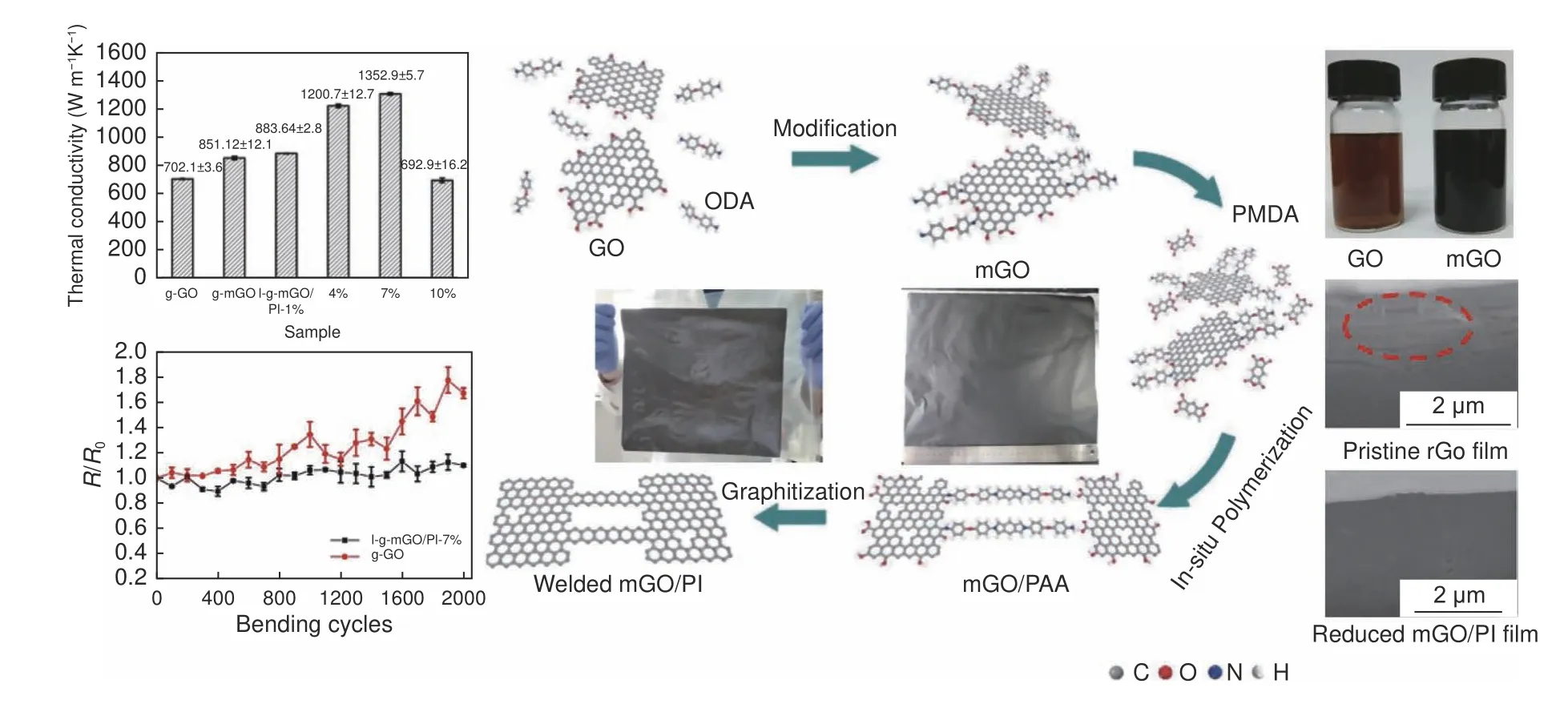
Fig.6 The illustration of modified molecular welding strategy of rGO/PI composite films[46, 51] (Copyright 2019,Royal Society of Chemistry and Copyright 2019,John Wiley and Sons).
3 The key factors for improving the thermal conductive performance
The graphene with a perfect lattice structure exhibits amazing thermal and electrical properties.But in fact,there are numerous defects in graphene sheets due to the preparation and assembly process of graphene film.As concluded in Fig.7,the lattice defects such as vacancies,grain boundaries and the functionalization by oxygen or nitrogen containing groups are easily to give rise to strong phonon-phonon scattering.Whereas the gaps or the crumples between graphene sheets mainly caused during the assembly of micron-sized graphene or GO sheets may result in a phonon-boundaries scattering to hamper the thermal transfer.With the rising of graphene as a potential heat dissipation spreader,more and more theoretical prediction of the thermal performance based on molecular dynamic (MD) or density functional theory(DFT) have been approached for improving theκof graphene based composite films.
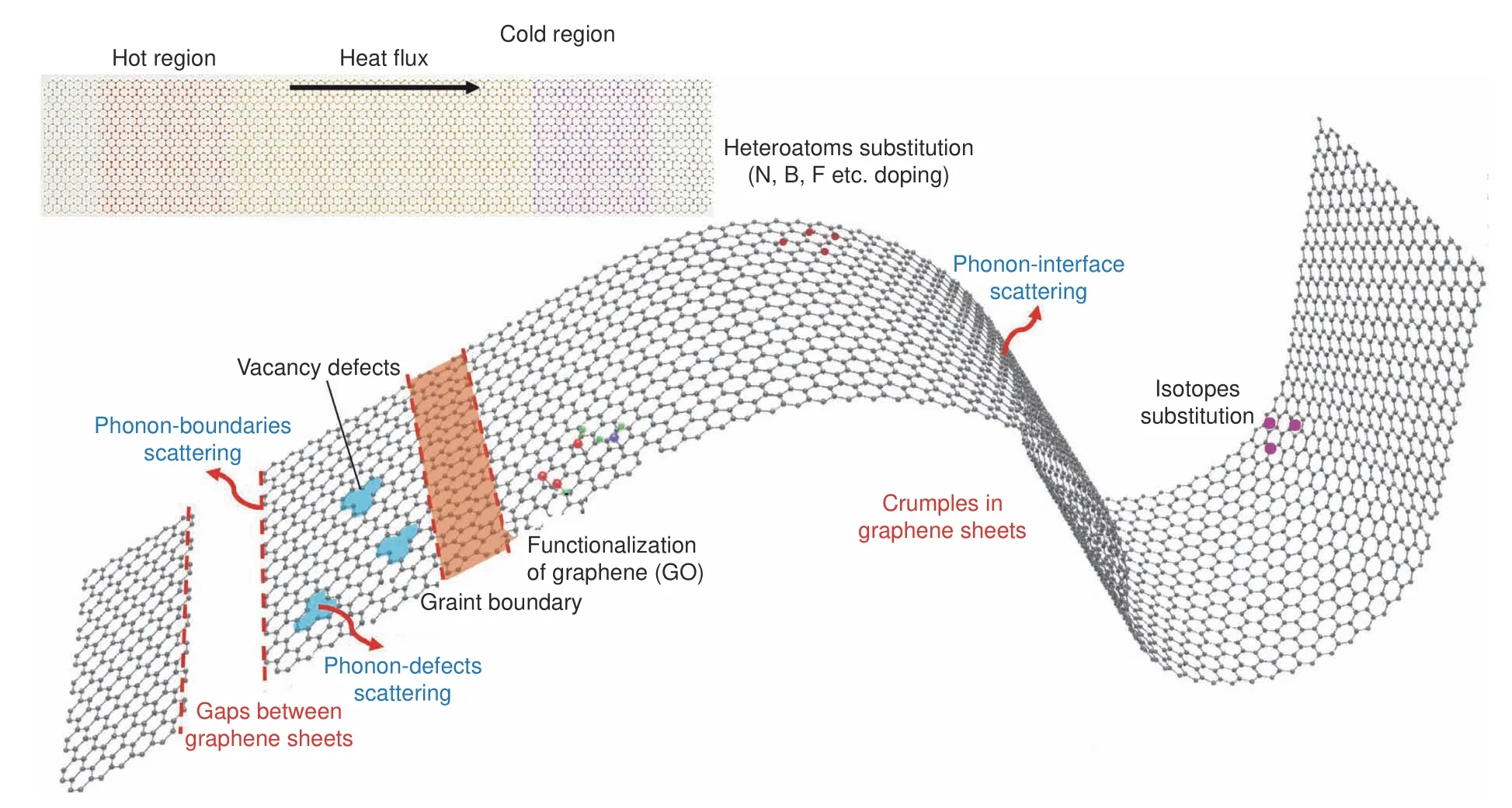
Fig.7 The illustration of defects and lattice mismatch in graphene sheets to summarize the key factors to heat dissipation of graphene films[58](Copyright 2012,Material Research Society).
In this section,both the experimental and theoretical results are taken into consideration to summary four important factors that influence the thermal and electrical properties of graphene and its composite films.
3.1 Structural defects
The harmonic sp2structure carbon atoms endows graphene an extremely highκ,while that of GO drops dramatically over 3 or 4 orders of magnitude due to the harsh oxidation at the edge or graphene plane.As shown in Fig.8,a detailed research focused on the defects and doping in graphene was proved that theκof defected and doped graphene follows an exponential relation with the defect and doping ratios[59].Chen et al.prepared a13C isotope labelled graphene film by a CVD method,which was achieved by introducing13CH4.And the results showed that with only 1% of13C doping,phonon transportation in the graphene lattice was greatly changed[60].Kim et al.calculated theκof doped graphene by first-principle and found that theκof graphene with impurities was only~10% of that of pristine graphene,suggesting that the heteroatoms in graphene have enhanced the electron-phonon scattering[61].
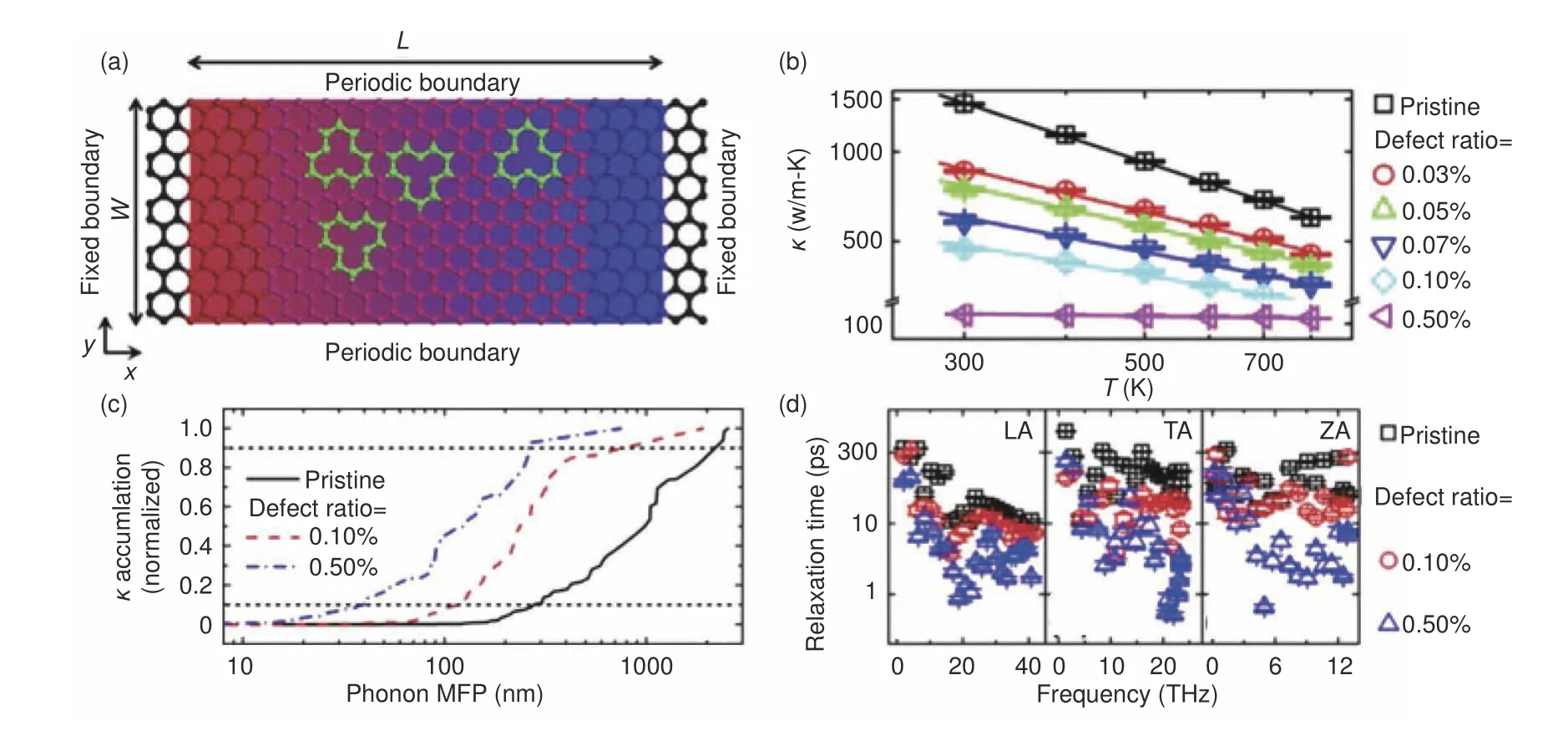
Fig.8 (a) Schematic diagram of the structural defects in graphene,(b) The thermal conductivities of graphene ribbon with different defect ratios.(c) The relationship between normalized thermal conductivity and the mean free path.(d) The relaxation time of different types of phonons[59] (Copyright 2017,Elsevier).
Besides the isotope or heteroatoms doping effect,the intrinsic structural defects,such as Stone-Wales,vacancies or line defects also showed influence in the phonon transportation.Xie et al.found that the thermal transport in zigzag graphene nanoribbon was affected by topological line defects with a lower normalized thermal conductance[62].The influence of vacancy defects in phonon properties of graphene was also calculated by Islam.The phonon scattering was affected with the increase of vacancies[63].Tan et al.stimulated the thermal transport property of graphene with pentagon-heptagon defects (PHDs) by non-equilibrium Green’s function approach.The results showed that the PHD had an influence on both the zigzag and armchair orientation,and theκwas insensitive to the width of the defect area[64].The detailed computational results about the influence of defects were reported that theκvalues were decreased by~57.6%,~42.4% and~31.9%,corresponding to single,double or Stone-Wales defects,respectively,even at a low concentration of 0.23%[65].
3.2 The size effect
The grain size of graphene sheets is also one of the important factors to determine the ballistic or diffusive phonon transportation.Notably,the concept of grain size is different from that of lateral size,for instance,the GO sheet with a large size can even reach 10 000 μm2,but its grain size is still small due to the structural defects.It is known that the length of phonon mean free path (MFP) exhibits a significant contribution to thermal transportation.
According to the NEMD stimulation,theκof the graphene nanoribbon follows an empirical formula[66,67]:

where κ∞represents the thermal conductivity of the limitation of fully diffusive phonon transportation,Lcis the critical length of ballistic and diffusive mode.Nika et al.took into account the anharmonic threephonon process to the second-order together with the angle dependent scattering to reveal the size dependence of the κ of graphene sheets[68].Xu et al.conducted the measurement of graphene sheets (longest size of 9) withκvalues of 1 689 W(m k)−1to 1 813 W(m k)−1at room temperature.Furthermore,the NEMD stimulation of heat transportation in graphene was similar to the experiments.The κ was observed to increase with the length of the sample and to scale as logL,whenLis one order of magnitude longer than the average MFP[69].Park et al.established a graphene supercell with different lengths and the results showed that theκwas increased linearly and dominated by phonon ballistic transportatio when the length was below 800 nm while with the further increasing in length,the diffusive thermal transport dominated.It was estimated that the macroscopic limit ofκin graphene sheets could reach 3 200 W(m k)−1[70].
Great efforts on experimental research were also taken to confirm the importance of the size effect on thermal conductive performance.For example,as mentioned in Fig.9,Lee et al.manipulated CVD conditions to control the grain size of polycrystalline graphene.The in-planeκof graphene sheets with sizes of 4.1,2.2 and 0.5 μm were 2 660,1 890 and 680 W(m·k)−1,respectively,indicating a positive relation between the thermal conductive performance and the grain size of graphene[71].A modified segregation–adsorption CVD (SACVD) method was developed to control a uniform grain size from~200 nm to~1 μm on a Pt substrate.Theκwas dramatically decreased with decreasing the grain size while the electrical conductivity was reduced slowly[72].
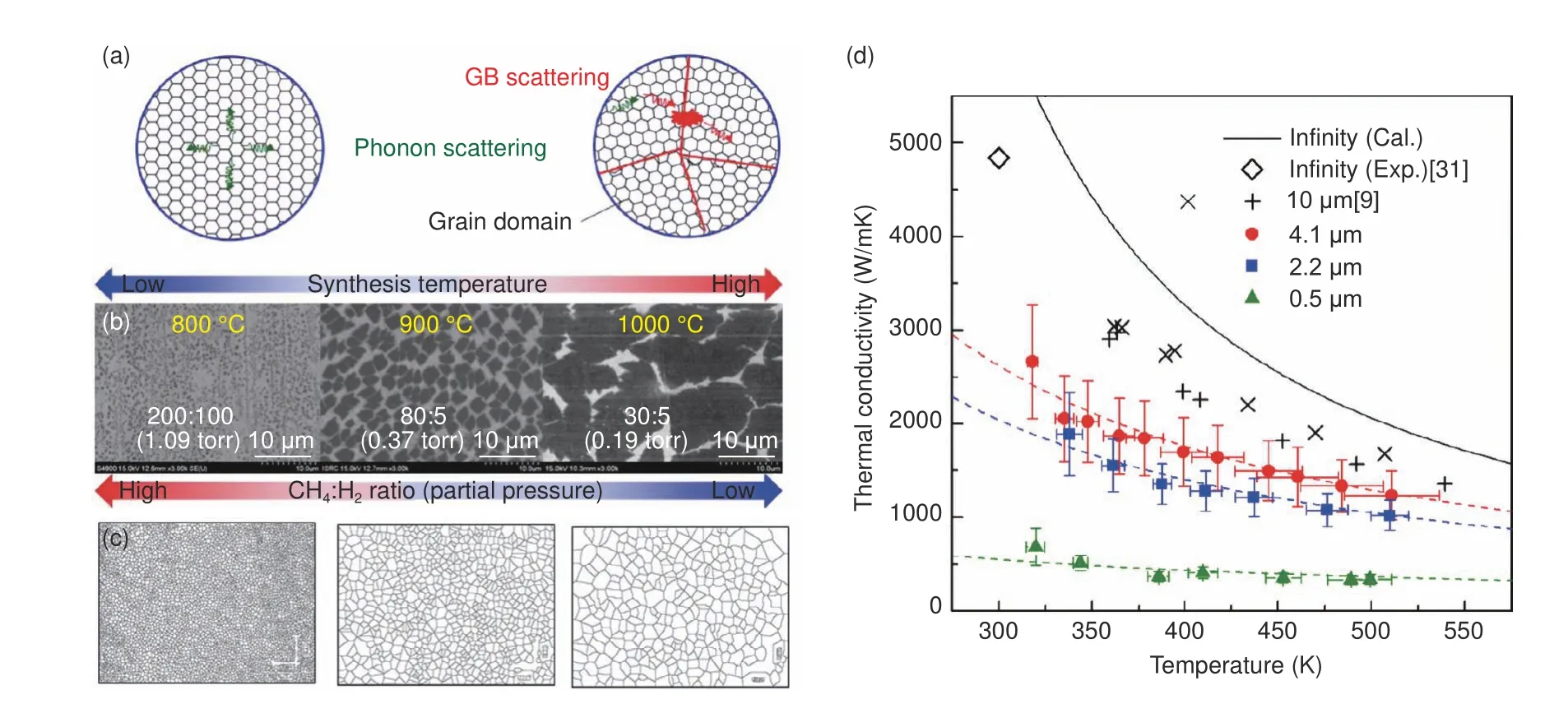
Fig.9 (a) The diagram of the grain domain of graphene by the CVD method.(b and c) The SEM and the digital treated images of grain domain grown at different temperatures and gas pressures.(d) The thermal conductivity of graphene film with different grain sizes[71] (Copyright 2017,Elsevier).
To evaluate the size effect of GO and graphene sheets,as shown in Fig.10(a-e),Kumar et al.collected GO with large size (L-GO) by a centrifugation method.According to the SEM images,the size of L-GO reached~40 μm,while that of small sized GO(S-GO) was only 5 μm.The L-GO showed a superior EMI shielding performance,and theκof rL-GO was 1 390 W(m k)−1,35% higher than that of rS-GO films[73].Peng et al.prepared a debris-free rGO (DfrGO) film with an extremely highκof 1 950 W(m k)−1as well as excellent flexibility.As mentioned in Fig.10(f-l),the microfolds formed by LGO endowed the film a much higher elongation as well as superior tolerance of small radius twist[25].

Fig.10 (a,b) The SEM images of centrifugal collected L-GO and S-GO.(c) The digital photos of L-GO and rL-GO films.(d and e) The thermal and EMI shielding performance of rL-GO and rS-GO films[73] (Copyright 2015,Elsevier).(f) The illustration of the formation of micro-folds achieved by debris-free GO sheets.(g-h) The cross-sectional and the surface morphologies of the DfrGO film.(j) The optical images of DfrGO film with excellent flexibility.(k and l) The heat dissipation performance and the thermal conductivity of DfrGO film[25] (Copyright 2017,John Wiley and Sons).
3.3 The interfacial effect
When the graphene sheets are in contact with a substrate,the interfacial phonon scattering and coupling are also critical problems for thermal transportation,either in parallel or vertical direction of a graphene film.The interfacial coupling results in a remarkable decrease inκof graphene nanosheets by 67%,when the number of graphene layers increases from 1 to 4[74].The experimental results also support this viewpoint.The κ of the suspended graphene sheet is 5 300 W(m k)−1,but that of the exfoliated graphene attached on a silicon wafer is dramatically reduced to~600 W(m k)−1[75],due to strong interfacial phonon scattering between graphene and silicon lattices.According to the further MD stimulation results,theκshowed an order-of-magnitude reduction because of the damping of the out-of-plane acoustic (ZA)[76].
Besides the phonon scattering between graphene sheets or the substrate,that caused by the numerous interfaces between graphene layers inside the film is also a primary source of thermal resistance,during the assembly of graphene sheets into a condensed film.For example,Renteria et al.found that the graphene layer separation forming“air pockets”inside the rGO film would greatly decrease the cross-planeκ,due to the interfacial phonon scattering[77].So far,there are two strategies to improve the density or compactness of graphene films.On one hand,various assembly methods with extra force are approached to control or enhance the orientation of rGO film.For instance,due to the extremely large Kerr coefficient of GO,the degree of ordering and the alignment of GO could be controlled under low electric fields[78].Zhai et al.applied an external electrical potential to achieve an ordered alignment forming a 3D network from isolated clusters[79].Inspired by the centrifugal casting of metal belt,in Fig.11,Zhong et al.developed a centrifugal casting of GO and its composite film with improved orientation of GO sheets.The electrical conductivity of rGO film increased to 650 S cm−1with increasing the rotation speed corresponding to the oriented alignment of GO sheets[57].By tuning the layer distance of GO sheets,it also showed a potential application in desalination or filtration.

Fig.11 (a) The demonstration of GO film prepared by a centrifugal casting method,(b) The optical photo of the meter-scale free-standing GO film,(c) The optical photo and the SEM image of the reduced GO film[57].
On the other hand,the thermal treatment of rGO films would release carbon monoxide or carbon dioxide[80,81] to expand the GO sheets,reducing the density of the thermal conducting film.Hence,the compression during or after the annealing is also an effective approach to enhance the density of the heat dissipation films.Concretely,the vacuum assisted hot pressing played an important role to suppress the expansion of graphene or rGO films.The rGO film annealed in a confined space preserved a better integrity than that treated in a free space[81].According to our research,the thickness of rGO films prepared by a hot-pressing process was more than 20 μm smaller than that annealed without pressure.Additionally,the roughness of the film surface was also superior[49].
4 Conclusions and outlook
As presented above,in this review,we discuss the recent progress on graphene-based films from the perspective of the preparation methods and the key factors for heat dissipation performance.It is hard to figure out which raw material or method is the best for thermal management.Each method has accuracy problems related to the grain or lateral size and the orientation of graphene sheets.
Generally speaking,the reduced GO film shows excellent processability,which is suitable for most of the preparation method,even for the scalable industrial production.But due to the large amounts of defects introduced during the oxidation treatment,the graphitization at extremely high temperature (2 800 °C to 3 000 °C) is necessary to restore the defects in rGO films.The graphene film made by the mechanical exfoliated graphene sheets shows disadvantages in the processing method and the anti-bending performance,because of the weak interaction between graphene sheets.The graphene-based composite films have been widely applied for efficient heat dissipation with several advantages.The carbon fibers,CNTs or polymer based graphitic structure can afford pathway for phonon transportation between micron sized graphene sheets to enhance theκof pristine rGO or graphene film.
Both the theoretical and experimental results prove that the structural defects,grain or lateral size and the orientation of graphene sheets are important factors for the thermal conductive properties of graphene films,corresponding to the phonon scattering occurred at the defects,grain boundaries or the interface of graphene sheets.
Up to date,the graphene-based films exhibit great potential in thermal management,such as the LED bulb,mobile phone and coating for traditional heat sink.Hence the quality enhancement and the cost reduction of the industrial scale graphene or GO is still one of the most important issues.
Acknowledgments
This work was supported by Shanghai Sailing Program (20YF1432100,20YF1432200),the Innovation Program of Shanghai Municipal Education Commission (2019-01-07-00-E00015),Shanghai Scientific and Technological Innovation Project(19JC1410402),Science and Technology Commission of Shanghai Municipality (20060502200) and the Program for Professor of Special Appointment (Eastern Scholar) at Shanghai Institutions of Higher Learning.
- 新型炭材料的其它文章
- TiC-modified CNTs as reinforcing fillers for isotropic graphite produced from mesocarbon microbeads
- A mini review:application of graphene paper in thermal interface materials
- Thermal conductivity of graphite nanofibers electrospun from graphene oxide-doped polyimide
- One-pot modified“grafting-welding”preparation of graphene/polyimide carbon films for superior thermal management
- Microstructure of high thermal conductivity mesophase pitch-based carbon fibers
- Properties and microstructures of a matrix graphite for fuel elements of pebble-bed reactors after high temperature purification at different temperatures

